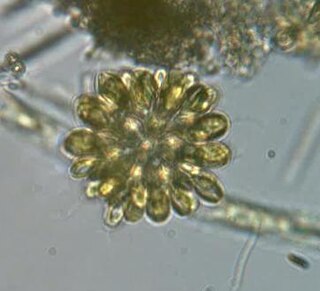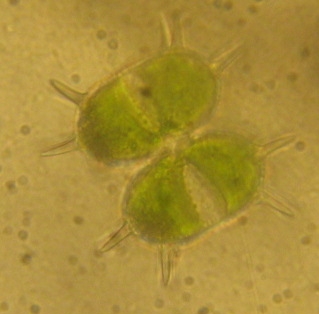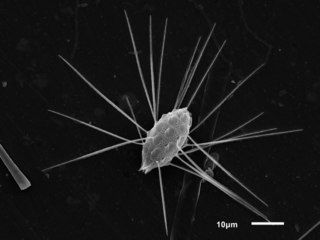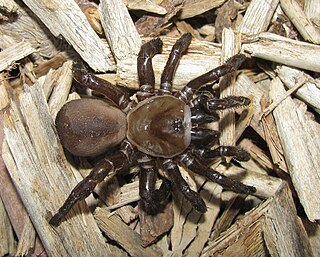
The Chlorophyceae are one of the classes of green algae, distinguished mainly on the basis of ultrastructural morphology. They are usually green due to the dominance of pigments chlorophyll a and chlorophyll b. The chloroplast may be discoid, plate-like, reticulate, cup-shaped, spiral- or ribbon-shaped in different species. Most of the members have one or more storage bodies called pyrenoids located in the chloroplast. Pyrenoids contain protein besides starch. Some green algae may store food in the form of oil droplets. They usually have a cell wall made up of an inner layer of cellulose and outer layer of pectose.

The synurids are a small group of heterokont algae, found mostly in freshwater environments, characterized by cells covered in silica scales.

Desmidiales, commonly called the desmids, are an order in the Charophyta, a division of green algae in which the land plants (Embryophyta) emerged. Desmids consist of single-celled, microscopic green algae. Because desmids are highly symmetrical, attractive, and come in a diversity of forms, they are popular subjects for microscopists, both amateur and professional.

Charophyta is a group of freshwater green algae, called charophytes, sometimes treated as a division, yet also as a superdivision or an unranked clade. The terrestrial plants, the Embryophyta emerged within Charophyta, possibly from terrestrial unicellular charophytes, with the class Zygnematophyceae as a sister group.

Micrasterias is a unicellular green alga of the order Desmidiales. Its species vary in size reaching up to hundreds of microns.

Eustigmatophytes are a small group of eukaryotic forms of algae that includes marine, freshwater and soil-living species.

Lagerheimia is a genus of green algae in the family Oocystaceae. It is commonly found in freshwater habitats all over the world, although some species are rare and have only been recorded from Europe or the United States.

Stephanosphaera is a genus of green algae in the family Haematococcaceae, containing the single species Stephanosphaera pluvialis. It forms colonies of flagellated cells. Although it was once placed in the family Volvocaceae, it is not closely related to them; its sister is the unicellular genus Balticola.

The Desmidiaceae are one of four families of charophyte green algae in the order Desmidiales (desmids).

Cosmarium is a genus of freshwater organisms belonging to the Charophyta, a division of green algae from which the land plants (Embryophyta) emerged.

Desmidium is a genus of green algae, specifically of the Desmidiaceae.

Triploceras is a genus of desmid in the family Desmidiaceae.

Xanthidium is a genus of green algae, specifically of the Desmidiaceae.

Micrasterias furcata is a species of unicellular desmid which inhabits freshwater areas. M. furcata is round, flattened and lobed in body plan.

Claudea is a marine red alga genus.
Cosmarium tetragonum is a species of green algae in the family Desmidiaceae. It is a freshwater species with a worldwide distribution.

Mallomonas is a genus comprising unicellular algal eukaryotes and characterized by their intricate cell coverings made of silica scales and bristles. The group was first named and classified by Dr. Maximilian Perty in 1852. These organisms live in freshwater and are widely distributed around the world. Some well known species include Mallomonas caudata and Mallomonas splendens.

Halonoproctidae is a family of mygalomorph spiders, split off from the family Ctenizidae in 2018. Species in the family are widely distributed in North and Central America, Australasia, Asia, southern Europe and North Africa. One species is recorded from Venezuela in South America. They are relatively large, sombrely coloured spiders, that live in burrows with some kind of trapdoor.
Coolia is a marine dinoflagellate genus in the family Ostreopsidaceae. It was first described by Meunier in 1919. There are currently seven identified species distributed globally in tropical and temperate coastal waters. Coolia is a benthic or epiphytic type dinoflagellate: it can be found adhered to sediment or other organisms but it is not limited to these substrates. It can also be found in a freely motile form in the water column. The life cycle of Coolia involves an asexual stage where the cell divides by binary fission and a sexual stage where cysts are produced. Some of the species, for example, Coolia tropicalis and Coolia malayensis, produce toxins that can potentially cause shellfish poisoning in humans.
Cryptoglena(/ˌkɹɪptoʊˈgliːnə/) is a genus of photosynthetic euglenids that was first described in 1831 by Christian Gottfried Ehrenberg. Today, its circumscription is controversial: Bicudo and Menezes consider twenty-one species as Cryptoglena, of which, nine are uncertain. Cryptoglena species are water-based, living in both freshwater and marine environments. They are biflagellated, with one internal flagellum and one external flagellum, which allows movement through environments as demonstrated by Kim and Shin in the species C. pigra. The cells of Cryptoglena resemble a coffee bean, as they have a groove that runs the length of the cell on one side and makes them U-shaped in cross section. They are ovoid in shape and are small, with the larger cells being on average 25 x 15 μm. After being first described in 1831, little work was done on the genus until the late 1970s and early 1980s, after the scanning electron microscope completed development and was implemented into laboratories. Work then proceeded with the developments of molecular biology, which allows for classifications based on DNA sequences. For Cryptoglena the main DNA used for classification are small subunit (SSU) and large subunit (LSU) rDNA.














